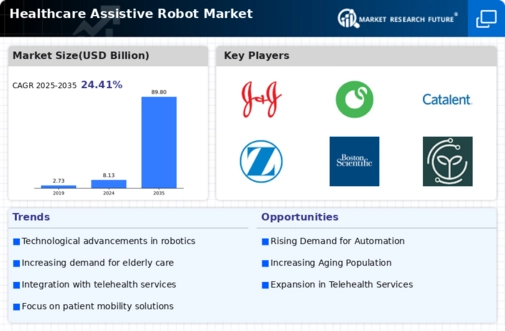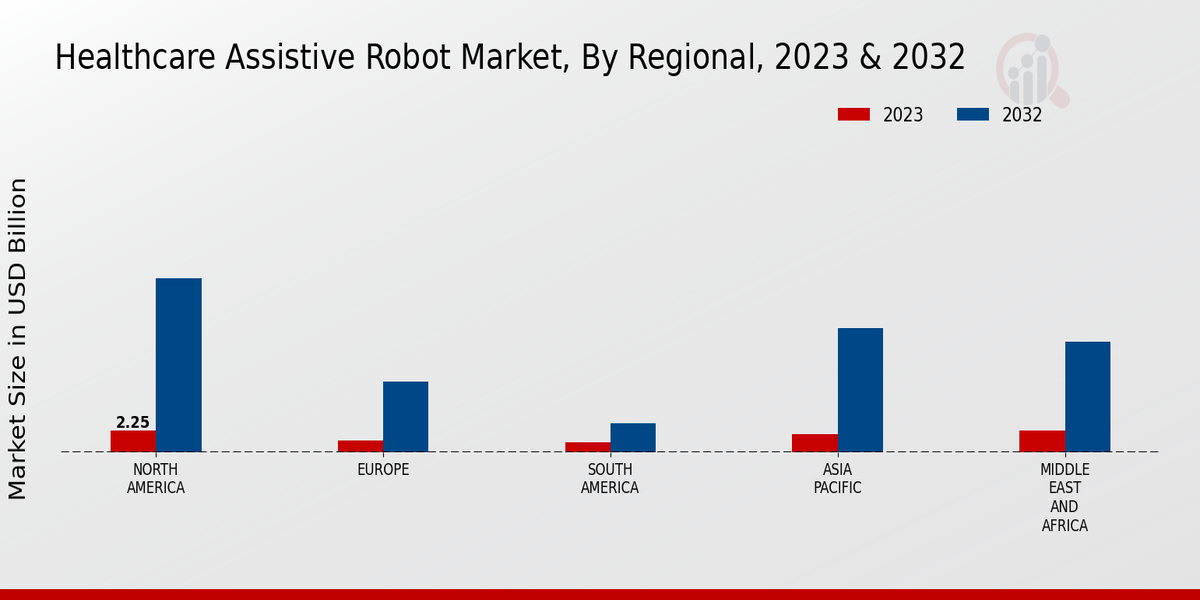Rising Aging Population
The Global Healthcare Assistive Robot Market Industry is experiencing growth due to the increasing aging population worldwide. As individuals age, they often require assistance with daily activities, leading to a higher demand for healthcare robots. By 2024, the market is projected to reach 8.13 USD Billion, reflecting the urgent need for innovative solutions to support elderly care. Countries with significant aging demographics, such as Japan and Germany, are particularly driving this trend. Healthcare assistive robots can enhance the quality of life for seniors, providing companionship and support, which is essential as the global population over 65 continues to rise.
Market Growth Projections
The Global Healthcare Assistive Robot Market Industry is projected to experience substantial growth in the coming years. By 2024, the market is expected to reach 8.13 USD Billion, with forecasts indicating a remarkable rise to 89.8 USD Billion by 2035. This growth trajectory suggests a compound annual growth rate of 24.41% from 2025 to 2035. Such projections highlight the increasing acceptance and integration of assistive robots in healthcare settings, driven by technological advancements and changing demographics. The market's expansion reflects a broader trend towards automation and innovation in healthcare, positioning assistive robots as vital components in future healthcare delivery.
Technological Advancements
Technological advancements play a crucial role in the expansion of the Global Healthcare Assistive Robot Market Industry. Innovations in artificial intelligence, machine learning, and robotics are enabling the development of more sophisticated and efficient healthcare robots. These advancements allow for improved interaction between robots and patients, enhancing the overall user experience. As technology evolves, the capabilities of assistive robots are likely to expand, making them more appealing to healthcare providers and patients alike. This trend is expected to contribute to the market's growth, with projections indicating a substantial increase in value, potentially reaching 89.8 USD Billion by 2035.
Regulatory Support and Funding
The Global Healthcare Assistive Robot Market Industry is also influenced by regulatory support and funding initiatives from governments. Many countries are recognizing the potential of assistive robots in improving healthcare delivery and are implementing policies to encourage their development and adoption. This support often includes grants, subsidies, and favorable regulations that facilitate research and innovation in robotics. As a result, the market is likely to experience accelerated growth, with increased investment in the development of new technologies. Such initiatives not only enhance the capabilities of assistive robots but also ensure their integration into healthcare systems, paving the way for a more efficient future.
Increased Healthcare Expenditure
The Global Healthcare Assistive Robot Market Industry is benefiting from increased healthcare expenditure across various nations. Governments and private sectors are investing heavily in healthcare infrastructure, which includes the integration of assistive robots. This investment is driven by the need to improve patient care and reduce operational costs in healthcare facilities. As healthcare budgets expand, the adoption of assistive robots is likely to rise, facilitating better patient outcomes and efficiency in care delivery. The anticipated compound annual growth rate of 24.41% from 2025 to 2035 underscores the potential for growth in this sector, as more facilities seek to incorporate advanced technologies.
Rising Demand for Home Healthcare
The Global Healthcare Assistive Robot Market Industry is witnessing a surge in demand for home healthcare solutions. As more patients prefer receiving care in the comfort of their homes, healthcare robots are becoming essential tools for providing assistance. These robots can help with medication management, mobility support, and even companionship, addressing the diverse needs of patients. The trend towards home healthcare is likely to continue, driven by the desire for personalized care and cost-effectiveness. This shift is expected to significantly impact the market, as the integration of assistive robots becomes increasingly common in home settings, enhancing the quality of care provided.



















